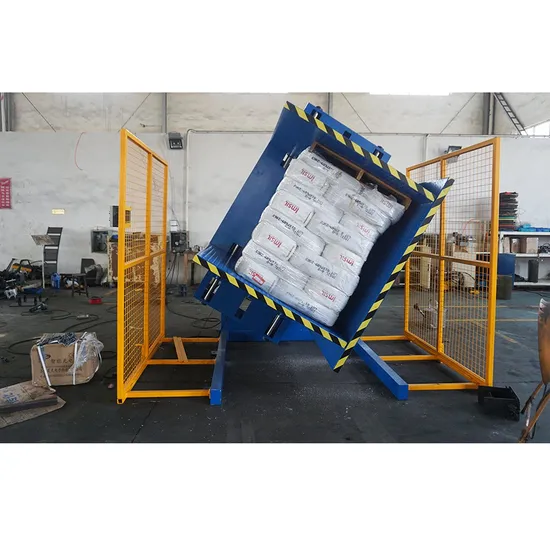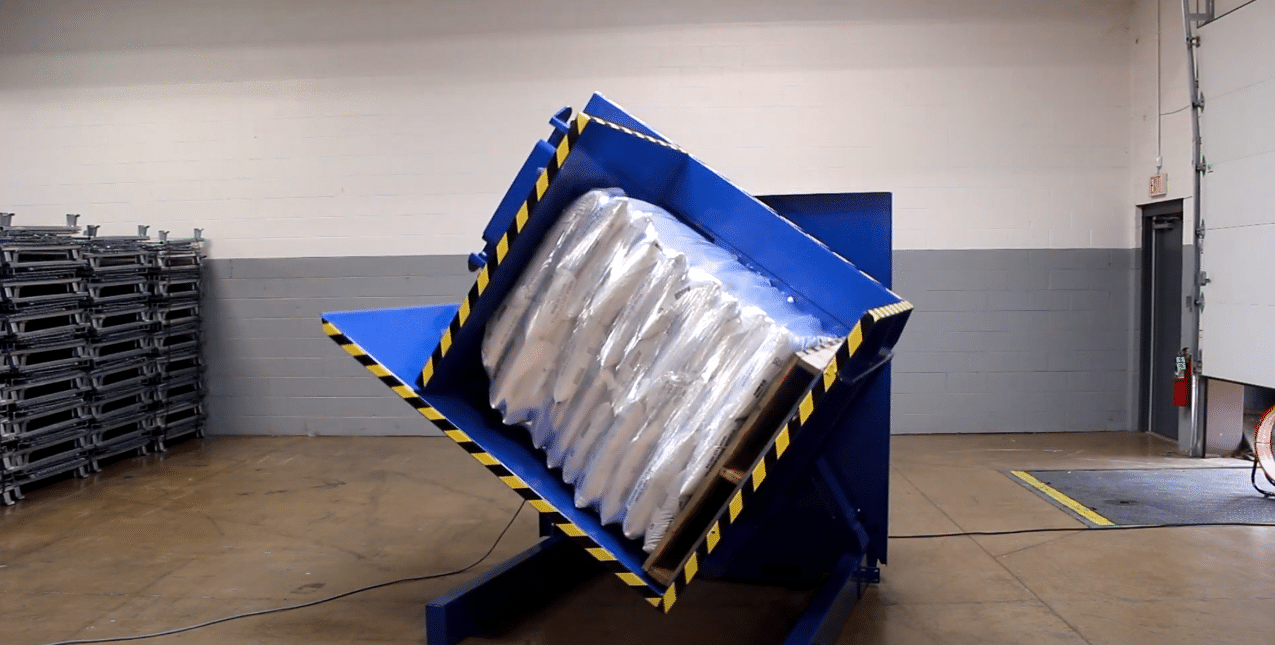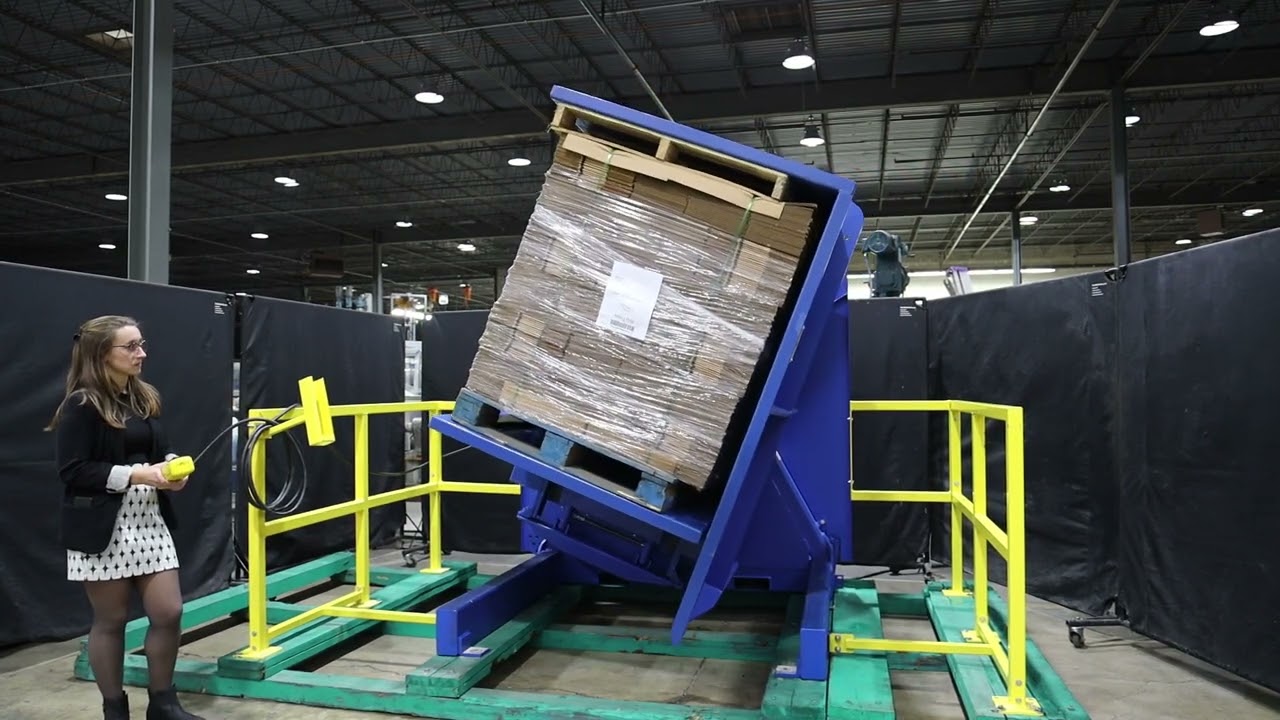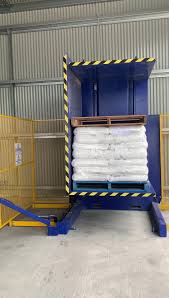Pallet Changing Machine: How to Prevent Color Bleed When Swapping Fabric Pallets?
You have beautiful, high-quality fabric rolls sitting on wooden pallets, ready for the next stage. But you need to move them to clean, standardized in-house pallets for production or shipping. The problem is that one splinter, one dirty spot on an old pallet, or one careless move can cause colors to bleed or transfer. This single mistake can ruin an entire roll of fabric. It's a frustrating loss of time, money, and material. And it can damage your reputation with your clients. The solution is using the right pallet changing machine paired with a well-defined process. This approach isn't just about swapping pallets; it is about protecting the integrity and value of your product at a critical handling point.
To prevent color bleed when swapping fabric pallets, the most effective method is to use a pallet changing machine that has smooth, non-porous contact surfaces, such as polished stainless steel or specially coated plates. It is also critical to ensure the machine applies gentle, evenly distributed clamping pressure and is thoroughly cleaned between handling batches of different colored fabrics to eliminate any risk of cross-contamination.

This might seem straightforward, but achieving perfect results every time depends on the details. The specific type of machine you choose, the procedures your team follows, and even the cleanliness of the surrounding environment all play a significant role. Throughout my career, I've seen many businesses face this exact challenge. I started on the factory floor and eventually built my own company, SHJLPACK, so I've seen these problems from both sides. I want to share what I've learned from years of experience to help you protect your valuable inventory and streamline your operations. Let's break down the key elements you need to get this right.
What specific machine features are crucial for handling delicate fabric rolls?
You've identified the need for a pallet changer, but it's important to understand that not all machines are created equal. Choosing a standard machine built for rugged goods like canned foods or engine blocks could be a disaster for your delicate fabric rolls. Imagine a clamping system designed for a ton of steel applying that same force to the cardboard cores of your fabric, crushing them instantly. Or picture a rough, painted steel platform snagging threads and ruining the finish of your product. The wrong machine doesn't just fail to solve your problem; it actively creates new, more expensive ones. The key is to look for specific features designed to handle sensitive loads. It's about finding a machine that treats your product with the same level of care and precision that you do.
When handling delicate fabric rolls, the most crucial features for a pallet changer include adjustable, soft-touch clamping pads, a variable pressure control system, and smooth, non-snagging load platforms. These platforms are often made of polished stainless steel or have specialized coatings. A 180-degree pallet inverter is frequently the preferred style, as it fully cradles and supports the load throughout the entire transfer process, minimizing stress on the product.

The Critical Role of Pressure Control
The heart of a pallet changer's interaction with your product is its clamping system. For fabric rolls, this cannot be a simple on/off mechanism. You need precision and the ability to adjust the pressure. A machine with a hydraulic or pneumatic system that includes a pressure regulator is essential. This allows your operators to dial in the exact amount of force needed—just enough to secure the load without causing any damage. Over-pressuring is a common mistake with basic machines. It can crush the cardboard or plastic cores of your fabric rolls, making them difficult or impossible to use on your production equipment. It can also create permanent creases in the fabric itself, rendering sections of the roll useless. In my experience, the ability to set and forget a specific, gentle pressure setting for different products is one of the most valuable features for ensuring consistent, damage-free handling.
Why Contact Surface Material Matters
The surfaces of the pallet changer that touch your product are just as important as the pressure system. Any roughness, rust, or flaking paint can snag delicate fibers or transfer contaminants. This is why material choice is not a minor detail. Standard painted steel is simply not suitable for high-quality textiles. The paint can chip over time, creating sharp edges and areas that trap dirt.
Here’s a simple breakdown of the common options:
| Feature | Polished Stainless Steel | Teflon/UHMW Coating | Standard Painted Steel |
|---|---|---|---|
| Smoothness | Excellent | Superior (lower friction) | Poor (can snag threads) |
| Cleaning | Easy to wipe down and sanitize | Very easy, has non-stick properties | Difficult, can hold dirt in chips |
| Durability | High, resistant to corrosion | Good, but can wear over time | Low, prone to chipping and rust |
| Contamination Risk | Low | Very Low | High |
For most textile applications, polished stainless steel is the gold standard due to its durability and cleanability. Specialized polymer coatings like Teflon or UHMW can offer even lower friction, which is beneficial for extremely delicate fabrics.
Machine Type: Pallet Inverter vs. Pallet Pusher
Finally, the style of the machine makes a huge difference. A "pallet pusher" works by pushing the entire load from the old pallet to the new one. This can work for stable, solid loads, but it's risky for stacked fabric rolls, which can shift, slide, or topple during the transfer. A "pallet inverter," on the other hand, clamps the load from the top and bottom, rotates the entire package by 180 degrees, and then rests it on the new pallet. The load is supported at all times. I remember a client in the textile industry who initially purchased a pallet pusher to save on cost. They quickly ran into issues with rolls becoming misaligned and damaged. After switching to a 180-degree pallet inverter, these problems disappeared completely. The inverter provides the stability and security that delicate, cylindrical products like fabric rolls require.
How can operational procedures minimize the risk of color transfer?
So, you've invested in the perfect pallet changing machine with all the right features. It has adjustable pressure, and smooth stainless steel surfaces. Yet, your team still reports an occasional smudge or a faint line of color transfer from a dark roll to a light one. This is an incredibly frustrating situation. You spent the capital and made the right choice in equipment, but you're not getting the flawless results you expected. It's easy to blame the machine, but often, the real issue is hiding in plain sight. The problem usually lies within the daily workflow and operational habits. The truth is, a great machine needs a great process to deliver its full potential. By implementing a few simple, consistent procedures, you can eliminate those final imperfections and achieve perfect, repeatable quality control.
To effectively minimize the risk of color transfer, you must implement a strict cleaning protocol for the pallet changer's contact surfaces, especially when switching between batches of dark and light-colored fabrics. Additionally, using protective layers like clean slip sheets on top of pallets and training operators to inspect both the machine and pallets for dirt or debris before every cycle are essential steps.

The "Clean-Between-Colors" Protocol
This is the most important procedure you can implement, and it is absolutely non-negotiable for any facility handling different colored products. Microscopic dye particles can easily transfer from a black or red fabric roll onto the clamping plate and then onto the next white or beige roll. The solution is a simple but mandatory Standard Operating Procedure (SOP) for cleaning. It should look something like this:
- Complete the Batch: Finish the entire run of a single color (e.g., navy blue rolls).
- Visual Inspection: Before starting the next batch, the operator must perform a quick visual inspection of the clamping plates, side walls, and loading platform.
- Wipe Down: The operator uses designated cleaning supplies, such as lint-free cloths and an appropriate cleaning solution (like isopropyl alcohol), to thoroughly wipe down all surfaces that will contact the product.
- Log the Cleaning: For accountability, the operator initials a simple log sheet confirming the cleaning was performed. This small step reinforces the importance of the task.
- Begin New Batch: The machine is now ready for the next batch of a different color (e.g., pristine white rolls).
This entire process takes less than two minutes but can save thousands of dollars in ruined product.
The Power of Protective Layers
Think of this as a low-cost insurance policy. Even with a clean machine, the pallet itself can be a source of contamination. A simple, clean barrier between the pallet and your bottom roll of fabric can prevent any issues. This doesn't have to be complicated. A sheet of clean kraft paper, a thin plastic sheet, or a dedicated, reusable polymer slip sheet can serve as this protective layer. For just a few cents per pallet, you add a final layer of defense that ensures the base of your product stack remains as clean as the top. This is especially important when moving from dirty wooden pallets to clean plastic ones.
Operator Training and Ownership
A machine, no matter how advanced, is only as effective as the person operating it. Training is paramount. Your operators shouldn't just know which buttons to press. They need to understand why these procedures are so critical to the company's bottom line and quality standards. I've found that one of the best ways to ensure compliance is to give operators a sense of ownership. At one client's factory, we designated a lead operator as the "Quality Guardian" for the pallet changing station. They were responsible for training others, ensuring supplies were stocked, and championing the cleaning protocols. This small shift in responsibility transformed the process. The team took pride in their work, and contamination issues dropped to zero. When your team understands the impact of their actions, they become your first and best line of defense against quality problems.
Are there material handling alternatives to pallet changers for sensitive goods?
You're facing the challenge of swapping pallets while protecting your product, and a pallet changer seems like the most direct solution. But as a business owner or plant manager, it's wise to ask: Is it the only solution? Investing in a significant piece of equipment is a major decision that involves capital, floor space, and integration with your existing workflow. You might worry about these factors and wonder if there is a simpler, cheaper, or different way to achieve the same goal. As an engineer, I firmly believe in choosing the right tool for the job. To do that, you must first understand all the tools available. While pallet changers are often the most efficient and safest solution, exploring the alternatives is a crucial step in making a fully informed and confident decision for your operation.
Yes, alternatives to pallet changers exist for handling sensitive goods, but they almost always involve more manual labor, have lower throughput, and carry a higher risk of product damage. Common alternatives include manually restacking goods from one pallet to another, using pallet tippers combined with manual handling, or employing specialized forklift attachments. However, these methods typically fall short in terms of safety, efficiency, and product protection when compared to a dedicated pallet changer.

The Default Method: Manual Re-stacking
This is the most basic approach: having workers physically move the fabric rolls one by one from the old pallet to the new one. The only advantage is that it requires no capital investment in machinery. However, the disadvantages are overwhelming for any professional operation. It is extremely slow, driving up labor costs significantly. More importantly, it poses a high risk of ergonomic injuries to your employees from repetitive lifting and awkward postures. Every time a roll is handled, there is a chance for it to be dropped, dirtied, or damaged. For a business focused on efficiency and safety, this method is simply not a sustainable or scalable solution.
A Step Up: Pallet Tippers and Tilters
Pallet tippers are machines that tilt a loaded pallet to a 90-degree angle, making it easier for an operator to slide the goods off or a new pallet on. They reduce some of the heavy lifting associated with manual re-stacking, which is a positive step for ergonomics. However, this method still relies heavily on manual intervention. The operator still needs to guide and handle the product, meaning the risk of contamination and damage from direct contact remains high. Furthermore, the tilting motion can cause unstable loads like stacked rolls to shift and become disorganized. While better than pure manual labor, it's an intermediate solution that doesn't fully solve the core problems of product integrity and efficiency.
The Forklift Approach: Specialized Attachments
Some operations use specialized forklift attachments, like push-pull devices that work with slip sheets, to transfer loads. In this scenario, the entire load is pushed from one pallet onto another. This can be faster than manual methods, but it requires highly skilled forklift operators to execute without damaging the product. The pushing force can be too aggressive for delicate fabric rolls, potentially causing them to telescope or become distorted. The risk of snagging the fabric on the edge of the pallet or the attachment itself is also a significant concern.
Here is how these alternatives stack up against a purpose-built pallet inverter:
| Method | Speed | Labor Cost | Product Safety | Contamination Risk | Capital Cost |
|---|---|---|---|---|---|
| Manual Re-stacking | Very Slow | Very High | Very Low | Very High | None |
| Pallet Tipper | Slow | High | Low | High | Low |
| Forklift Attachment | Medium | Medium | Medium | Medium | Medium |
| Pallet Changer/Inverter | Fast | Very Low | Very High | Very Low | High |
When you analyze the options, it becomes clear. For businesses that prioritize product quality, operational speed, and employee safety, the initial investment in a proper pallet changer provides value that these other methods simply cannot match.
What is the ROI of investing in a specialized pallet changer for textiles?
As a business owner, you know that every major purchase must be justified on the balance sheet. A specialized pallet changer is a significant investment, and you need to be certain that it will pay for itself and contribute to your bottom line. It’s easy to see the upfront cost of the machine on a quote. It is much harder to quantify the hidden, persistent costs of your current method. A ruined roll of fabric here, an extra hour of labor there, the constant risk of a worker’s compensation claim from heavy lifting—these are the costs that silently eat away at your profit margins every single day. The good news is that calculating the Return on Investment (ROI) for a pallet changer is not just possible, it's an essential exercise. By analyzing the direct and indirect savings, you can build a clear business case that reframes the machine not as a cost, but as a future profit center.
The ROI for a specialized pallet changer is calculated by comparing the total investment cost against the combined financial savings it generates. The key areas of savings come from the near-total elimination of product damage costs (like those from color bleed or handling), a dramatic reduction in manual labor hours, faster operational throughput, and a lower risk of expensive workplace injuries and their associated claims.

Quantifying Product Savings
This is often the easiest number to calculate and the most shocking to see. Let's run a conservative example.
- Problem: Assume your current manual process results in one damaged roll of fabric per week, whether from being dropped, snagged, or contaminated by color bleed.
- Cost: If the average cost of a roll is $500.
- Annual Loss: $500 per roll x 52 weeks = $26,000 per year.
A pallet changer designed for delicate goods can reduce this product loss to virtually zero. This one metric alone can often justify the investment over a few years.
Calculating Labor Savings
This is where the efficiency gains become obvious.
- Manual Method: It might take two workers 15 minutes (0.25 hours each) to manually transfer a single pallet load. That's 0.5 total labor hours per pallet.
- Pallet Changer Method: It takes one worker just 2-3 minutes to complete the same task. Let's call it 0.04 hours.
- The Difference: You save approximately 0.46 labor hours for every pallet you transfer.
Now, let's scale that. If you transfer 20 pallets per day: - Daily Savings: 0.46 hours/pallet x 20 pallets = 9.2 labor hours saved every day.
- Annual Savings: Assuming a modest loaded labor rate of $25/hour, that's $230 per day, or over $57,500 per year (based on a 250-day work year). The freed-up labor can then be reallocated to more value-added tasks instead of manual handling.
The Hidden Financial Benefits (Indirect ROI)
Beyond direct savings, there are powerful financial benefits that protect your business.
- Injury Prevention: In any manual lifting operation, back and shoulder injuries are a constant threat. A single serious workers' compensation claim can cost tens of thousands of dollars in medical bills, lost time, and increased insurance premiums. A pallet changer completely eliminates the risk of lifting injuries from this specific task.
- Increased Throughput: Swapping a pallet in two minutes instead of fifteen means your materials get to the production line or the shipping dock faster. This boosts your entire plant's efficiency and capacity utilization, helping you meet tight deadlines and take on more orders.
- Enhanced Reputation: Consistently delivering perfect, clean, and undamaged products strengthens your reputation as a high-quality supplier. This builds client trust, reduces returns, and leads to more repeat business—a benefit that is difficult to price but incredibly valuable.
When you add up the savings from eliminated product waste, reduced labor, and prevention of injuries, the payback period for a pallet changer is often between 12 and 24 months. It is a strategic investment in quality, efficiency, and safety.
Conclusion
Preventing color bleed is about combining the right pallet changer with smart, consistent operational processes. This approach ensures total quality control and protects the value of your products.




